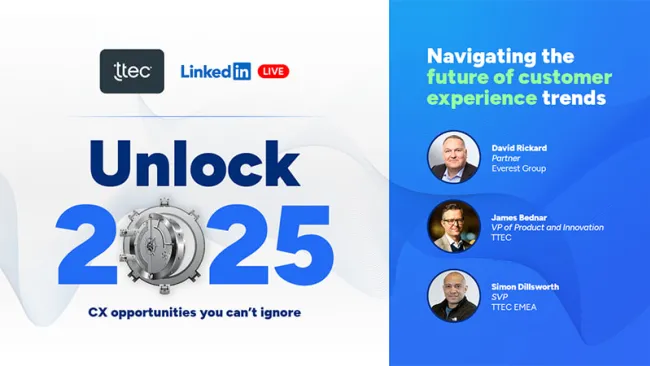Now’s that special time when the pundits declare what the new year holds for us and what customer experience leaders need to focus on. There’s usually some bold prognostications, embellished claims, and urgent calls to action. Often a gloomy threat that those who don’t acquiesce are doomed to irrelevance.
That’s not this.
When you’re in the public sector working with CX leaders in tolling/transportation, healthcare and human services marketplaces, you acquire a good grounding in reality. Less susceptible to hyperbole. Less tolerant of anything that wastes time, energy, or money. It’s a badge of pragmaticism we wear proudly.
It’s with a level-headed outlook I view the opportunities that 2025 will bring to those of us in government and public enterprises. TTEC’s just-published strategy guide, CX Trends 2025, explores five change-makers in the world of the customer experience and there’s two trends that resonate for the public sector: Extracting more value from our data and insights is one. Evolution of AI agents is the other.
All this is in pursuit of the ultimate goals: Providing excellent customer service while delivering continuous operational efficiency. The public sector has one of the biggest productivity improvement opportunities around. In recent research, McKinsey estimated the U.S. government’s opportunity to improve productivity at more than $700 billion annually. That works out to be more than $2,000 per resident each year. Pretty soon, you’re talking real money.
Data insights break through barriers
Turning raw data into insights that help shape a more informed strategy isn’t new. Getting better at data analytics — and tailoring the output for specific contingencies based on job roles — now that is new. I hear about this all the time. Clients need dashboards to help guide decision-making, but everyone’s needs are different depending on the scope of their job responsibilities.
In the contact center, associates use personal dashboards to track their individual performance and gamification makes it more fun. Not only does this contribute to improved job satisfaction and lower attrition rates, but associates are more engaged with coaching because they recognize which skills they need to strengthen. No one feels blind-sided when they have a one-on-one with their team lead and they’re more receptive to AI-enhanced training like RealSkill that improves speed to proficiency.
For supervisors, the data appetite is different: It’s their job to assess each associate’s proficiency, identify opportunities to improve, and develop an action plan tailored to the individual. This task is a heavy lift because the information needed to draft a plan usually resides in multiple, disconnected systems. It’s an arduous process — unless you’ve got dashboards that serve up the right information in near real time. For example, with TTEC’s performance enablement platform using AI algorithms to correlate behaviors with performance outcomes, team leads reclaimed 45 minutes to their workday because action plans were created 23% faster than was possible with a manual process.
Executive-level management needs their own custom dashboards, too, and I expect public sector leaders will invest in these enablement platforms to gain efficiencies to save costs in the coming year.
AI agents make their mark on self service
This is not about old school chatbots that inspire eye-rolling because they so often fall short of expectations. Instead, think “autonomous agents” that transform the customer experience. How? Because they continually grow smarter, more predictive, and they are easier to integrate into existing CX systems and channels.
Consumers are more comfortable than ever working with AI agents today and 67% say they are expanding their range of inquiries. Among CX leaders, 72% expect AI agents to become an extension of their brand identity, according to Zendesk.
Any time there’s an opportunity to enhance self-service via the website or mobile apps and decrease call volume coming into the contact center, that’s a win. To learn more about autonomous agents also called “agentic AI,” check out Liz Glagowski’s just-published article in the Customer Strategist Journal, “Make way for autonomous AI agents: The next wave of AI comes ashore in 2025.”
For a deeper dive into all five trends, review our new strategy guide, CX Trends 2025, to see which opportunities will be a good fit for your organization.
















